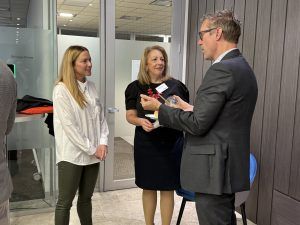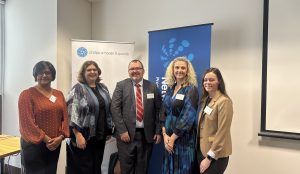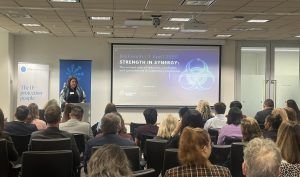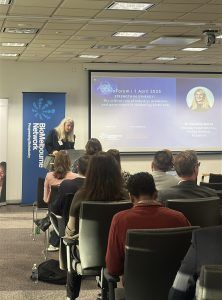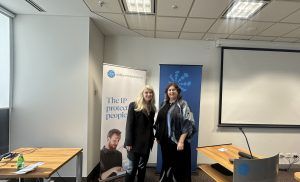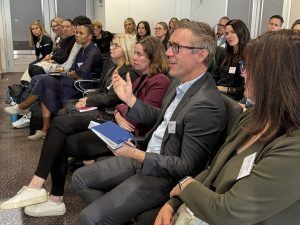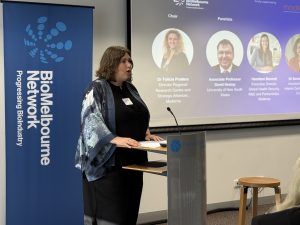In today’s globally-connected world, biological threats – whether naturally occurring, accidental, or deliberately engineered – pose an escalating risk to public health, economic resilience and national security. Confronting these challenges requires more than expertise; it demands true synergy between sectors.
In response, BioMelbourne Network brought together sector leaders for its latest BioForum “Strength in Synergy: The critical role of industry, academia and government in combating biothreats,” proudly supported by Moderna and hosted by Phillips Ormonde Fitzpatrick. The conversation focused on how industry, academia and government can collaborate to boost preparedness and resilience.
Bringing together around 60 sector leaders, researchers, policy-makers and innovators, the breakfast spotlighted the urgent need for stronger cross-sector collaboration to tackle evolving biothreats – from pandemics and antimicrobial resistance to the potential misuse of synthetic biology.
“Biothreats don’t recognise borders.” Karen Parr, CEO BioMelbourne Network
Opening the BioForum, BioMelbourne Network CEO Karen Parr set the tone by contextualising the conversation globally, referencing the World Health Organization’s 2023 Health Emergency Preparedness, Response and Resilience report, which identified biological threats as one of the top global health risks.
“Biothreats don’t recognise borders,” she noted, “and they’re not always what we expect.” From lab accidents and zoonotic spillovers to bioterrorism and gene-editing misuse, the panel explored the systemic challenges and the need for agility, foresight and collaboration.
The discussion was chaired by Dr Felicia Pradera, Director, Regional Research Centre and Strategic Alliances at Moderna, with insights from:
• Associate Professor David Heslop, University of New South Wales
• Hamilton Bennett, Executive Director, Global Health Security, R&D and Partnerships, Moderna, who flew in from the US
• Dr Samira Hassan, Assistant Secretary, Interim Centre for Disease Control
Together, the panel, voices representing industry, government and academia, highlighted the power of synergy across sectors, with each contributor emphasising the need to move from reactive to resilient systems. As Dr Pradera said, “Our risks are no longer isolated. They’re global. Collaboration is no longer optional. It’s essential.”
“We must bring more people into the collaborative system.”
With her global perspective, Hamilton Bennett reinforced the importance of international surveillance systems and data sharing, noting that rapid detection, containment and scalable response mechanisms are vital. “It’s not enough to just respond to one pathogen in one geography. We must bring more people into the collaborative system. Biothreats in one region inevitably become biothreats in another. It’s just a matter of how quickly we can detect and contain them.”
Amid uncertainty across the international landscape, including shifting funding and research priorities in the United States, Bennett also highlighted an opportunity for Australia – particularly Victoria – to step up and lead. Australia is globally-recognised as a home to world-class research institutions, a growing bio-manufacturing capacity, and a culture of trust in science and healthcare.
Bennett praised the country’s leadership in building onshore mRNA manufacturing capabilities and called attention to the value of Australia’s globally-connected, collaborative life sciences community. “This is your moment,” she said. “You have the ecosystem, the partnerships, and the scientific talent to shape the global future of health security.”
“You can have the right tools, but without the right systems, they don’t work.”
The conversation included Australia’s domestic preparedness, highlighting local successes in cross-sector collaboration. Dr Hassan shared real-world examples of cross-departmental coordination, including Australia’s recent H7 influenza outbreak in poultry, which prompted a proactive One Health approach integrating agriculture, environment and health experts.
Associate Professor Heslop added his insights from both military and public health perspectives, emphasising that resilient biosecurity systems rely not just on innovation, but on the ability to bring together diverse expertise. “You can have the right tools, but without the right systems, they don’t work,” he said.
He and his fellow panellists called for a “whole-of-system” approach—breaking down siloes between sectors and embracing the full spectrum of contributors, including clinicians, logisticians and even community leaders.
The erosion of public trust in science
He also focused on the need to build sovereign capacity not just through advanced manufacturing and product development but by strengthening public health systems and embracing informal, cross-sector relationships that underpin resilience. “A strong public health system,” he noted, “has a national security role.”
Particularly timely and candid comments addressed the erosion of public trust in science and the growing threat of misinformation. All panellists agreed that transparent, community-driven communication is vital.
As Dr Hassan shared: “During COVID-19, engaging community leaders and co-designing solutions with them helped us address vaccine hesitancy and misinformation – especially among non-English speaking communities.”
Bennett added that communication must be tailored: “Scientists often think publishing a paper is the end point, but for real public health impact, the information must reach people in ways they can understand and trust.” Heslop also advocated for “red-teaming” misinformation – anticipating how science might be misunderstood and proactively communicating more effectively.
“We need more space to tinker, to innovate, to collaborate.”
The panel also addressed challenges around securing funding for threat reduction. Heslop noted the need for more flexible, cross-disciplinary funding models and the value of in-kind contributions and collaboration over competition. “We need more space to tinker, to innovate, to collaborate – not just more money,” he said.
Across all themes, a central idea emerged: resilience depends on formal and informal relationships – between people, sectors, and systems.
As the session closed, BioMelbourne Network CEO Karen Parr underscored the core message: “Victoria’s life sciences ecosystem is deeply engaged in turning cutting-edge science into real-world solutions. But in an era of fast-moving biothreats, we must stay ahead of the curve – building trust, strengthening partnerships and future-proofing our systems.”
Join the new Advances in mRNA Science community on Wiliam
Attendees were encouraged to continue the conversation through BioMelbourne Network’s new Advances in mRNA Science community on Wilam – a digital hub for researchers, industry leaders and innovators, supported by Moderna.
This BioForum served as a reminder that meaningful innovation stems not just from science, but from shared purpose, open dialogue, and collective action. Or, as Bennett aptly stated:
“Reducing biothreats is not the work of one sector or one nation. It’s a global responsibility – and it starts with synergy.”

